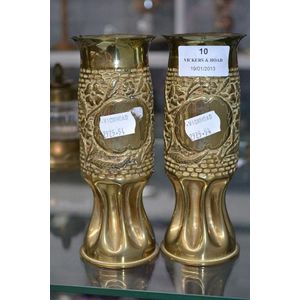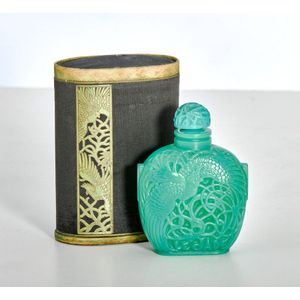Gilt Glass Perfume Bottle, Baccarat, 19th Century
You must be a subscriber, and be logged in to view price and dealer details.
Subscribe Now to view actual auction price for this item
When you subscribe, you have the option of setting the currency in which to display prices to $Au, $US, $NZ or Stg.
- Gilding - Gilding is a method of ornamentation whereby a thin sheet of gold metal is applied to items made of wood, leather, ceramics, glass and silver for decorative purposes.
For furniture including mirrors, the sheet of gold is usually applied over a coating of gesso. Gesso is a mixture of plaster of Paris and gypsum mixed with water and then applied to the carved wooden frames of mirrors and picture frames as a base for applying the gold leaf. After numerous coats of gesso have been applied, allowed to dry and then sanded a coat of "bole", a usually red coloured mixture of clay and glue is brushed on and allowed to dry, after which the gold leaf is applied. Over time parts of the gilding will rub off so the base colour can be seen. In water gilding, this was generally a blue colour, while in oil gilding, the under layer was often yellow. In Victorian times, gilders frequently used red as a pigment beneath the gold leaf.
Metal was often gilded by a process known as fire gilding. Gold mixed with mercury was applied and heated, causing the mercury to evaporate, the long-term effect of which was to kill or disable the craftsman or woman from mercury poisoning. The pursuit of beauty has claimed many victims, not the least of which were the artists who made those pieces so highly sought after today. - Attributed - A cataloguing term where the item in the opinion of the cataloguers, is a of the period of the artist, craftsman or designer, and which probably in whole or part is the work of that person.
- Cased Glass - Cased glass is a type of glassware that is made by sandwiching a layer of one colour of glass between two layers of another colour of glass. This technique is also known as "slip-casting" and "slip-decorated" or "overlay" glass. The process creates a decorative effect by contrasting the colours of the outer layers with the inner layer. The outer layers can be clear, opaque or coloured and the inner layer can be a different colour, or it can be left clear to create a more subtle effect.
The technique was first developed in the 19th century, primarily in Europe, and it was used to produce a wide range of decorative glassware such as vases, bowls, and bottles. Cased glass was particularly popular during the Art Nouveau period, when many glassmakers, including Loetz, Galle, Steuben and Tiffay began to experiment with different colours and designs to create unique and striking pieces of glassware.
This item has been included into following indexes:
- perfume / scent bottles, maker or location - Baccarat 12
-
perfume / scent bottles, material
- gilt / gold 141
- red glass 193
- ruby glass 144
- perfume / scent bottles, period - Victorian 470
Visually similar items

Pair of brass trench Art vases World War I (2)

A cloisonne & gilt rectangular snuff bottle, Qianlong four character and probably of the period, 1736-1795, decorated on both sides with a crane and deer, each side and the stopper with a lotus spray, the nreign mark incised on a gilt base, 7 cm high. Prov

A silver repousse oriental caddy marked 0.90, approx 92g

A Rene Lalique 'Le Jade' cased green glass perfume bottle for Roger et Gallet Paris, designed 1926, the Siros Collection, South Australia, the flask form body and stopper moulded with foliage and an exotic bird, moulded 'Roger Et Gallet Paris', 'Le Jade' a
